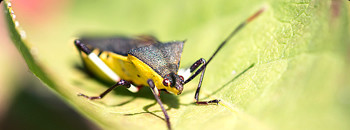Written by: Robin L. Tabuchi, Research Entomologist, University of California, Berkeley.
For many of us, summer vacation means spending time with family and friends, relaxing and travelling. Although I love travelling, there’s one pest I don’t look forward to sharing my vacation with; the infamous, blood-sucking bed bug! By now you’ve all heard of bed bugs, but you might not know how to avoid them.
Your bags are packed, the gas tank is full, and you’re ready to hit the road. Travelling can be quite an ordeal, and once you arrive at your destination, you’re tired and want to get settled in to your hotel room. Resist the temptation to unload everything from your car just yet. If you arrived by plane, either ask the hotel staff to bring your luggage up shortly, or take it with you and place it in the bathroom or non-carpeted entry. Now it’s time to inspect your room for bed bugs!
As with any pest, identifying it is the first step to protecting yourself and your belongings. Adult bed bugs are reddish-brown. Their bodies are oval and flattened, and they’re about the size of an apple seed. They don’t have wings, can’t jump, and only move by crawling. Bed bug nymphs are smaller in size and lighter than adults, but they look similar in appearance.

All bed bug nymphs and adults feed on blood. The nymphs need blood to molt and the adults need blood to mate and lay eggs. If a room has bed bugs, you’ll likely find fecal staining too (a.k.a. bed bug poop). Fecal staining is light brown to black and looks like tiny drops of dried blood.
Bed bugs are very good at hiding and can fit into tiny cracks and crevices. Begin your inspection with the bed and headboard, because after all, they are called bed bugs! They like to stay somewhat close to their food source and typically feed at night. Pull the sheets back and check mattress seams for adults, nymphs or fecal staining. Slide a credit card between the top of the headboard and the wall or remove the headboard and peek behind it.
Search other upholstered furniture for signs of bed bugs and walk around the room looking for fecal staining on walls, other furniture items, and the luggage rack.
What happens if you find a bed bug? If you’re brave, capture a specimen or take a photo. Discuss what you found with the hotel management. Request a new room and then inspect that room too.
What should you do if you don’t find anything? Just because you didn’t find something doesn’t mean there aren’t bed bugs. Keep personal items and clothing in a designated area of the room away from the bed. Bag your dirty laundry within your suitcase. Once you return home, leave luggage outside or in the garage and unpack there. Inspect luggage for bed bugs and then wash and dry all of your clothing on the warmest setting.
Safe travels!

